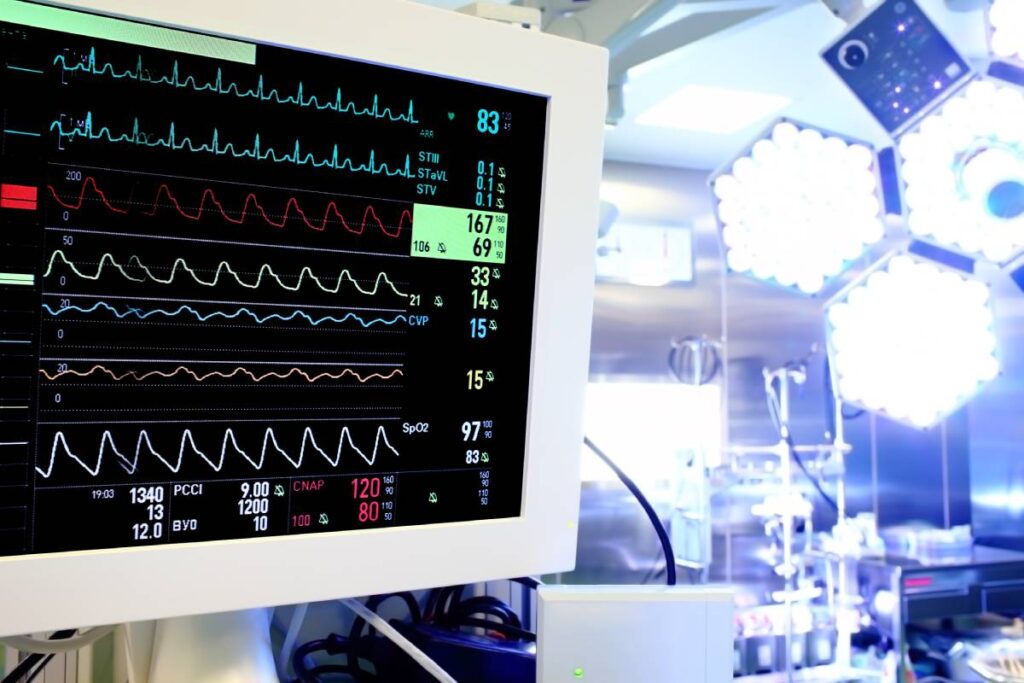During general anesthesia, anesthetists work to ensure the patient is not conscious and will not feel pain during a medical procedure. However, there are risks associated with general anesthesia, and it is crucial for a trained anesthetist to monitor the patient’s vital signs to ensure they remain within safe target zones (Smith et al., 2023). The risks of general anesthesia range from transient side effects such as minor confusion, temporary memory loss, dizziness, urinary retention, nausea, and vomiting, to more serious complications like persistent confusion and memory loss, heart attack, thromboembolism, pneumonia, and stroke (Smith et al., 2023). During general anesthesia, monitoring and management must cover vital sign targets that reflect cardiovascular, respiratory, and neurological status.
Two vital signs related to the cardiovascular system that must be monitored during general anesthesia are heart rate and blood pressure. It is preferred to maintain a heart rate between 60 and 100 beats per minute (Hafeez & Grossman, 2023), (Parida & Thangaswamy, 2017). Tachycardia (HR > 100 bpm) can indicate issues such as inadequate depth of anesthesia, pain, hypoxia, dehydration, or over-anesthetization (Parida & Thangaswamy, 2017). While blood pressure should be monitored regularly and often, there is not a clear consensus on the appropriate target BP for patients under general anesthesia (Meng et al., 2018). However, Meng et al. found that many nonrandomized studies show a relationship between perioperative blood pressure and patient outcomes (Meng et al., 2018). Management and monitoring of BP must be personalized to the patient and type of surgery. Various randomized controlled trials performed on both cardiac and noncardiac patients found that maintaining a higher BP may lead to better outcomes as compared to maintaining a lower BP (Meng et al., 2018).
Patients under general anesthesia cannot protect their airway and require assistance with breathing through methods such as endotracheal intubation or laryngeal mask. Related to the respiratory system, there are vital sign targets for the patient’s CO2 levels and oxygen saturation when under general anesthesia. Their respiration will be controlled on a ventilator (Ball, et al., 2018). The respiratory rate of a patient can be altered depending on their end-tidal CO2. End-tidal CO2 (EtCO2) should be kept in the 35-45 mmHg range as it is an indicator that the patient is expelling CO2. Hypercapnia, or excess of CO2 (EtO2 > 45 mmHg) can lead to respiratory acidosis (Chapman & Dragan, 2023). Oxygen saturation (SpO2) should remain above 95% to ensure adequate oxygenation (Gelaw et al., 2021). Synthetic opioids can cause respiratory depression and chest wall rigidity, so these patients must be carefully monitored (Smith et al., 2023).
Anesthetists may also need to monitor the depth of anesthesia to assess the patient’s level of anesthetization and autonomic and neuromuscular reflexes. A peripheral nerve stimulator is used perioperatively if a patient is given neuromuscular blocking drugs (Checketts et al., 2016). It is also important for the patient to remain at a certain body temperature. Perioperative hypothermia can lead to poor patient outcomes such as increased wound infections and blood loss as well as increased heart rate, blood pressure, and catecholamine levels. During general anesthesia, patients only have autonomic methods and external thermal help to maintain normothermia (Bindu et al., 2017). Unfortunately, perioperative temperature is not monitored as closely and commonly as other vital parameters.
Ultimately, effective monitoring and management of vital signs during general anesthesia is critical for patient safety and health. Anesthesiologists must monitor multiple specific parameters to ensure safe and optimal patient status. Most importantly, they must always be prepared to intervene if any of these vital signs leave the target range.
References
Ball, Lorenzo et al. “Respiratory mechanics during general anaesthesia.” Annals of translational medicine vol. 6,19 (2018): 379. doi:10.21037/atm.2018.09.50
Bindu, Barkha et al. “Temperature management under general anesthesia: Compulsion or option.” Journal of anaesthesiology, clinical pharmacology vol. 33,3 (2017): 306-316. doi:10.4103/joacp.JOACP_334_16
Chapman, Kyle. and Kristen E. Dragan. “Hypercarbia.” StatPearls, StatPearls Publishing, 3 July 2023.
Checketts, M R et al. “Recommendations for standards of monitoring during anaesthesia and recovery 2015: Association of Anaesthetists of Great Britain and Ireland.” Anaesthesia vol. 71,1 (2016): 85-93. doi:10.1111/anae.13316
Hafeez, Yamama. and Shamai A. Grossman. “Sinus Bradycardia.” StatPearls, StatPearls Publishing, 7 August 2023
Meng, Lingzhong et al. “Blood Pressure Targets in Perioperative Care.” Hypertension (Dallas, Tex. : 1979) vol. 72,4 (2018): 806-817. doi:10.1161/HYPERTENSIONAHA.118.11688
Parida, Satyen, and Chitra Rajeswari Thangaswamy. “Cardiac tachyarrhythmias and anaesthesia: General principles and focus on atrial fibrillation.” Indian journal of anaesthesia vol. 61,9 (2017): 712-720. doi:10.4103/ija.IJA_383_17
Smith, Guerin, et al. “General Anesthesia for Surgeons.” StatPearls, StatPearls Publishing, 5 August 2023.
Taye, Moges Gelaw et al. “Predictors of hypoxemia after general anesthesia in the early postoperative period in a hospital in Ethiopia: an observational study.” Multidisciplinary respiratory medicine vol. 16,1 782. 1 Dec. 2021, doi:10.4081/mrm.2021.782
